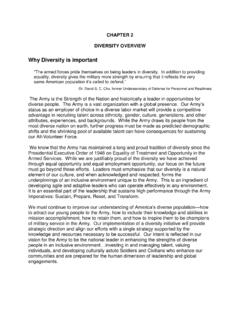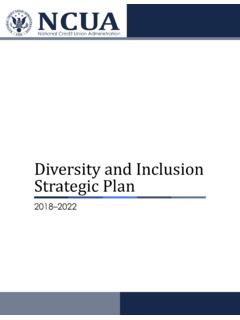Transcription of Holvino, E., Ferdman, B.M. and Merrill-Sands, D., 2004 ...
1 Holvino, E. H., Ferdman, B. M., & Merrill-Sands, D. (2004). Creating and sustaining diversity and inclusion in organizations: Strategies and approaches. In M. S. Stockdale & F. J. Crosby (Eds.), The psychology and management of workplace diversity (pp. 245-276). Malden, MA: Blackwell. References Acker, J. (1990). Hierarchies, jobs, bodies: A theory of gendered organizations. Gender and Society, 4, 139-158. Adler, N. J. (2002). International dimensions of organizational behavior, 4th ed. Cincinnati: South- Western. Arredondo, P. (1996). Successful diversity management initiatives: A blueprint for planning and implementation. Thousand Oaks, CA: Sage.
2 Bunker, (1990). Appreciating diversity and modifying organizational cultures: Men and women at work. In S. Srivasta, D. Cooperrider, and Associates (Eds.), Appreciative management and leadership: The power of positive thought and action in organizations (pp. 126-149). San Francisco: Jossey-Bass. Bunker, , & Alban, (1997). Large group interventions. San Francisco, CA: Jossey-Bass. Bushe, G. (in press). The new basics: Interpersonal competence and organizational learning. Unpublished manuscript. (Chapters can be accessed via ). Catalyst (1999). Women of color in corporate management: Opportunities and barriers. New York: Catalyst.
3 Chesler, M. (1994). Organization development is not the same as multicultural organizational development. In E. Y. Cross, J. H. Katz, F. A. Miller and E. W. Seashore (Eds.), The promise of diversity : Over 40 voices discuss strategies for eliminating discrimination in organizations (pp. 240-251). Burr Ridge, IL: Irwin. Chesler, M., & Delgado, H. (1987). Race relations training and organisational change. In Shaw, Nordlie, & Shapiro (Eds.), Strategies for improving race relations: The Anglo American experience (pp. 182-204). Manchester, UK: University Press. Chung, W. (1997). Auditing the organizational culture for diversity : A conceptual framework.
4 In Brown, Snedeker, & B. Sykes, (Eds.), Conflict and diversity (pp. 63-83). Cresshill: Hampton Press. Cole, , & Singer, B. (1991). A theoretical explanation. In H. Zuckerman, J. Cole, & J. Bruer (Eds.), The outer circle: Women in the scientific community (pp. 277-310). New York: Norton. Comer, D., & Soliman, C. (1996). Organizational efforts to manage diversity : Do they really work? Journal of Management Issues, 8, 470-483. Cooperrider, D. (1990). Positive image, positive action: The affirmative basis of organizing. In S. Srivasta, D. Cooperrider, & Associates (Eds.), Appreciative management and leadership: The power of positive thought and action in organizations (pp.)
5 91-125). San Francisco: Jossey-Bass. Cooperrider, , & Srivasta, S. (1987). Appreciative inquiry in organizational life. In Pasmore &. Woodman (Eds.), Research in organizational change and development (vol. 1 ) (pp. 129-169). Greenwich: JAI Press. Cox, T., Jr. (1991). The multicultural organization. Academy of Management Executive, 5, 34-47. Cox, T., Jr. (1993). Cultural diversity in organizations: Theory, research, and practice. San Francisco: Berrett-Koehler. Cox, T., Jr. (2001). Creating the multicultural organization: A strategy for capturing the power of diversity . San Francisco: Jossey-Bass. Cross, (2000). Managing diversity : The courage to lead.
6 Westport, CT: Quorum. Cumming, J., & Holvino, E. (1997). BEC: An example of collaborative inquiry with a social change organization. Unpublished handout, Chaos Management, Ltd., Brattleboro, VT. Dass, P., & Parker, B. (1999). Strategies for managing human resource diversity : From resistance to learning. Academy of Management Executive, 13(2), 68-80. Davidson, M. N., & Ferdman, B. M. (2001). A matter of difference- diversity and inclusion: What difference does it make? The Industrial-Organizational Psychologist, 39(2), 36-38. 1. Holvino, E. H., Ferdman, B. M., & Merrill-Sands, D. (2004). Creating and sustaining diversity and inclusion in organizations: Strategies and approaches.
7 In M. S. Stockdale & F. J. Crosby (Eds.), The psychology and management of workplace diversity (pp. 245-276). Malden, MA: Blackwell. Davidson, M. N., & Ferdman, B. M. (2002). A matter of difference-Inclusion and power: Reflections on dominance and subordination in organizations. The Industrial-Organizational Psychologist, 40(1), 62-67. Digh, P. (1998). The next challenge: Holding people accountable. HRMagazine, 43 (11), 63-69. Elliott, C. (1999). Locating the energy for change: An introduction to appreciative inquiry. Winnipeg, Canada: International Institute for Sustainable Development. Ellis, C., & Sonnenfeld, J. A. (1994). Diverse approaches to managing diversity .
8 Human Resource Management, 33, 79-109. Ely, R. J. (1994). The effects of organizational demographics and social identity on relationships among professional women. Administrative Science Quarterly, 39, 203-238. Ely, R. J., & Meyerson, D. E. (2000). Theories of gender in organizations: A new approach to organizational analysis and change, Research in Organizational Behavior, 22, 105-153. Falletta, S. V., & Combs, W. (2002). Surveys as a tool for organization development and change. In J. Waclawski & A. H. Church (Eds.), Organization development: A data-driven approach to organizational change (pp. 78-102). San Francisco: Jossey-Bass.
9 Ferdman, B. M. (1997). Values about fairness in the ethnically diverse workplace. [Special Issue: Managing in a global context: diversity and cross-cultural challenges]. Business and the Contemporary World: An International Journal of Business, Economics, and Social Policy, 9, 191-208. Ferdman, B. M., & Brody, S. E. (1996). Models of diversity training. In D. Landis & R. Bhagat (Eds.), Handbook of intercultural training, 2nd ed. (pp. 282-303). Thousand Oaks, CA: Sage. Ferdman, B. M., & Davidson, M. N. (2002). A matter of difference-Inclusion: What can I and my organization do about it? The Industrial-Organizational Psychologist, 39(4), 80-85.
10 Fitzgerald, S. P., Murrell, K. L., & Newman, H. L. (2002). Appreciative inquiry: The new frontier. In J. Waclawski & A. H. Church (Eds.), Organization development: A data-driven approach to organizational change (pp. 203-221). San Francisco: Jossey-Bass. Fletcher, J. K. (2002, August). The greatly exaggerated demise of heroic leadership: Gender, power, and the myth of the female advantage (CGO Insights Briefing Note No. 13). Boston: Simmons School of Management Center for Gender in Organizations. [Downloaded from ]. Foldy, E. (1999, July). Managing diversity : Identity and power in organizations. Paper presented at the First International Critical Management Studies Conference, Manchester, England.



